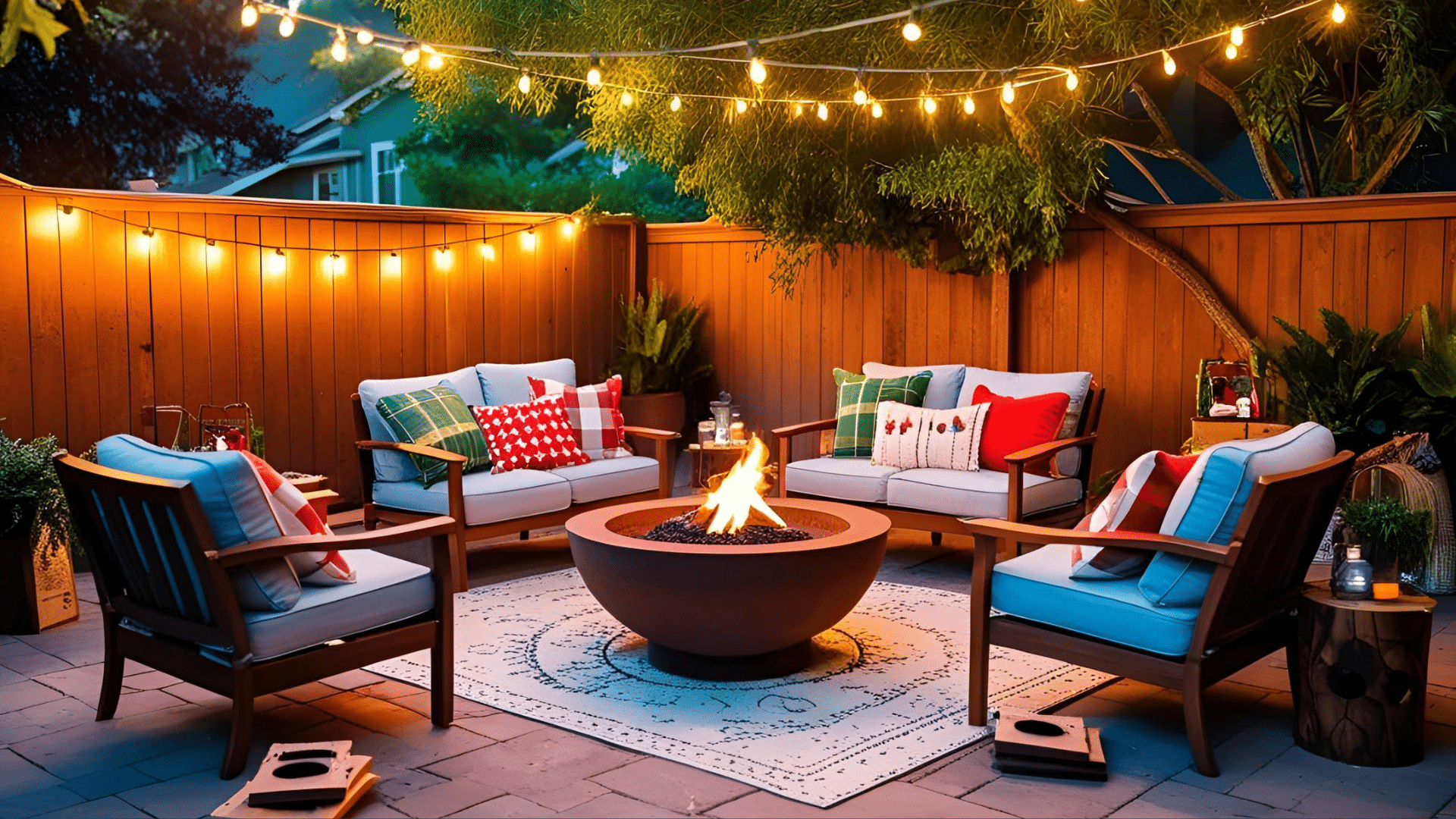How to Create a Home-Hearted Beautiful Landscape?
Landscaping is like interior design for your outdoor spaces, a way to extend your home’s personality beyond its walls.
Just as a well-decorated living room can make your house feel inviting, thoughtful landscaping can transform your yard into a beautiful and functional extension of your home.
Whether you’re creating a cozy garden retreat, a lively entertaining area, or a welcoming entryway, landscaping allows you to bring the same care and creativity to your outdoor spaces as you do inside.
At Home-Hearted, I believe landscaping is about more than just plants and patios, it’s about creating outdoor spaces that reflect your style and fit your lifestyle.
In this guide, I’ll explore tips, ideas, and trends to help you plan and design a Home Hearted Landscape that feels like home, whether you’re a DIY enthusiast or prefer professional help.
These ideas, I am sure, will add a sense of calmness and beauty to your landscaping journey.
Why Landscaping Matters?
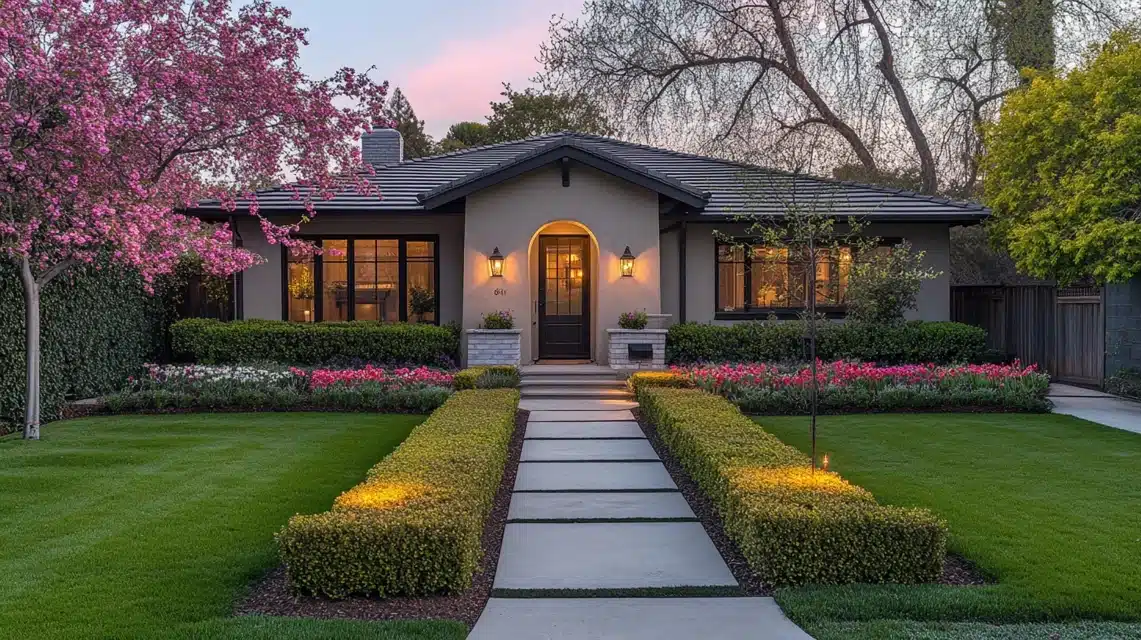
Think of your yard as your home’s welcome mat to the world.
As someone who’s spent countless hours transforming outdoor spaces, I can tell you that landscaping isn’t just about keeping up with the Joneses – it’s about creating a space that makes you smile every time you pull into your driveway.
1. Boosting Curb Appeal
Remember the last time you walked past a house with perfectly trimmed hedges, blooming flower beds, and a manicured lawn?
That’s the power of good landscaping! I’ve seen homes completely transformed by simple changes like adding layered flower beds with year-round bloomers, installing modern landscape lighting, and creating clear pathways to the front door.
My favorite curb appeal trick is planting flowering trees like dogwoods or cherry blossoms near your entrance.
They create a stunning natural archway that draws the eye right where you want it—to your beautiful home.
2. Extending Your Living Space Outdoors
Your backyard is potentially hundreds of square feet of untapped living space.
I learned this firsthand when I transformed my basic backyard into an outdoor living room with a cozy seating area, ambient lighting, and a small herb garden.
Consider creating distinct “zones” in your outdoor space:
- A peaceful reading nook under a pergola with comfortable weatherproof cushions and a small side table for your favorite beverages
- An outdoor dining area perfect for summer barbecues, complete with string lights and potted herbs nearby for fresh garnishes
- A play area for kids that blends naturally with the landscape, using rubber mulch under play equipment and surrounding it with hardy, child-safe plants
- A meditation garden with a small water feature for those stressful days, enclosed by ornamental grasses for privacy and sound buffering
3. Increasing Property Value
Here’s something I always tell my friends, landscaping is one of the few home improvements that increases in value over time.
While interior trends come and go, mature trees and established gardens only get better with age.
Smart landscaping investments that I’ve seen pay off include:
- Installing a proper irrigation system to maintain healthy greenery and reduce water waste through smart scheduling
- Planting shade trees on the south and west sides to reduce energy costs, my utility bills dropped by 20% after my maples matured!
- Adding privacy landscaping with evergreen shrubs like arborvitae or holly, which create natural boundaries that look better than fences
- Creating low-maintenance, drought-resistant gardens that appeal to future buyers while keeping your monthly maintenance costs down
Remember, the key to successful landscaping is starting with a solid plan that considers both your immediate enjoyment and long-term benefits.
DIY Landscaping Guide and Tips
Listen, I know how overwhelming landscaping can feel when you’re just starting out. I remember staring at my bare yard, thinking, “Where do I even begin?”
But here’s the secret I’ve learned: successful landscaping is all about starting small and building confidence as you go.
Let me share some practical tips that have helped me transform outdoor spaces without breaking the bank or getting overwhelmed.
1. Starting Small
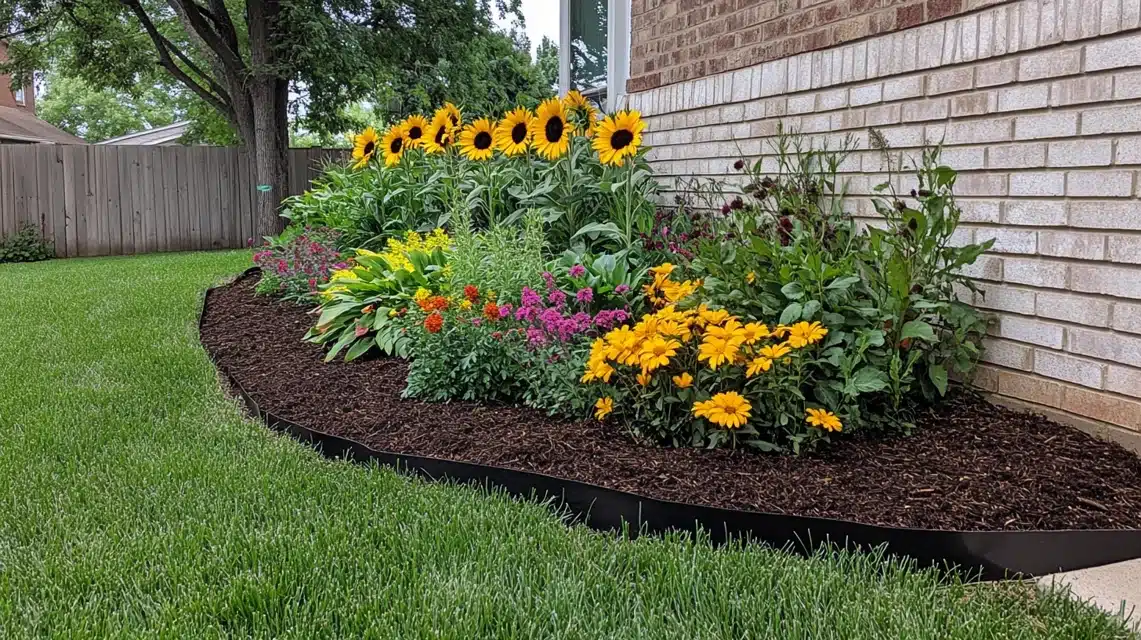
The best way to begin your landscaping journey is with manageable projects that give you quick wins.
When I first started, I transformed one small corner of my yard at a time, and before I knew it, the whole space had changed.
Begin with a simple flower bed near your entrance – it’s amazing what you can do with just a 4×8 foot area.
I always recommend starting by laying cardboard over the grass to naturally kill it, then adding quality soil and 2-3 types of flowers you love.
Remember my favorite beginner’s rule: “thriller, filler, spiller” – tall plants in the back, medium in the middle, trailing plants in front.
Mastering the art of mulching is another great starting point. I can’t tell you how many weekends I’ve spent mulching, but it’s truly one of the best skills to learn.
Calculate your needs (1 cubic yard covers about 100 square feet at 3 inches deep) and apply when the soil is moist but not wet.
Keep mulch 2-3 inches from plant stems and tree trunks, and layer 2-4 inches deep for optimal weed control.
2. Budget-Friendly Hacks

You don’t need a fortune to create a beautiful landscape. Some of my most successful projects came from thinking creatively about materials and resources.
Clever Material Repurposing
- Turn fallen branches into natural borders
- Use broken concrete pieces (“urbanite”) for stepping stones
- Convert old pallets into vertical gardens
- Repurpose wine bottles as garden bed borders
Smart Plant Choices
- Divide existing perennials to fill new spaces
- Trade plants with neighbors (I got all my hostas this way!)
- Choose native plants that thrive naturally in your area
- Start plants from seeds or cuttings
DIY Pathway Solutions
- Create paths using free wood chips from local tree services
- Make stepping stones using simple concrete forms
- Edge paths with bricks found on marketplace sites
- Use crushed granite for an affordable, durable surface
3. Seasonal Maintenance

The secret to a gorgeous landscape year-round is knowing what to do and when to do it.
In Spring (March-May), focus on cleaning up winter debris, pruning dead branches, and applying pre-emergent weed control when soil hits 55°F. Edge garden beds, add fresh mulch, and divide perennials before new growth starts.
Summer care (June-August) is all about proper watering – deep but infrequent, about 1-1.5 inches per week. Keep up with deadheading flowering plants to encourage blooming, and mow high (3-4 inches) to promote root growth. Don’t forget to check for pest issues weekly.
Fall preparation (September-November) is crucial for a healthy garden. Plant spring bulbs and new trees or shrubs, clean up fallen leaves (I shred them for free mulch!), and protect tender plants before the first frost. As temperatures drop, reduce watering gradually.
Winter protection (December-February) involves applying winter mulch after the ground freezes and protecting evergreens from winter burns with burlap. Check for snow damage after storms, and use this quieter season to plan next year’s projects – it’s actually my favorite winter activity!
Remember: gardening success is about progress, not perfection. Every “mistake” is actually a learning opportunity—trust me, I’ve had plenty!
Start with these basics, and don’t be afraid to experiment as you gain confidence. Take plenty of “before” pictures, too. You’ll be amazed at the transformation when you look back at where you started.
Pro Tips for Getting Started
- Start with a soil test to understand what plants will thrive in your yard
- Consider your local climate and choose native plants for easier maintenance
- Think about year-round interest – mix evergreens with seasonal bloomers
- Don’t forget about lighting – it extends your outdoor enjoyment into the evening
- Plan your irrigation system early – it’s much harder to install after plants are established
Landscaping Ideas for Every Home
In my experience transforming outdoor spaces for both myself and others, I’ve discovered that the most successful landscaping ideas are those that balance beauty with practicality.
Let’s explore some proven design concepts that can work for any home, regardless of its size or style.
1. Front Yard Landscaping
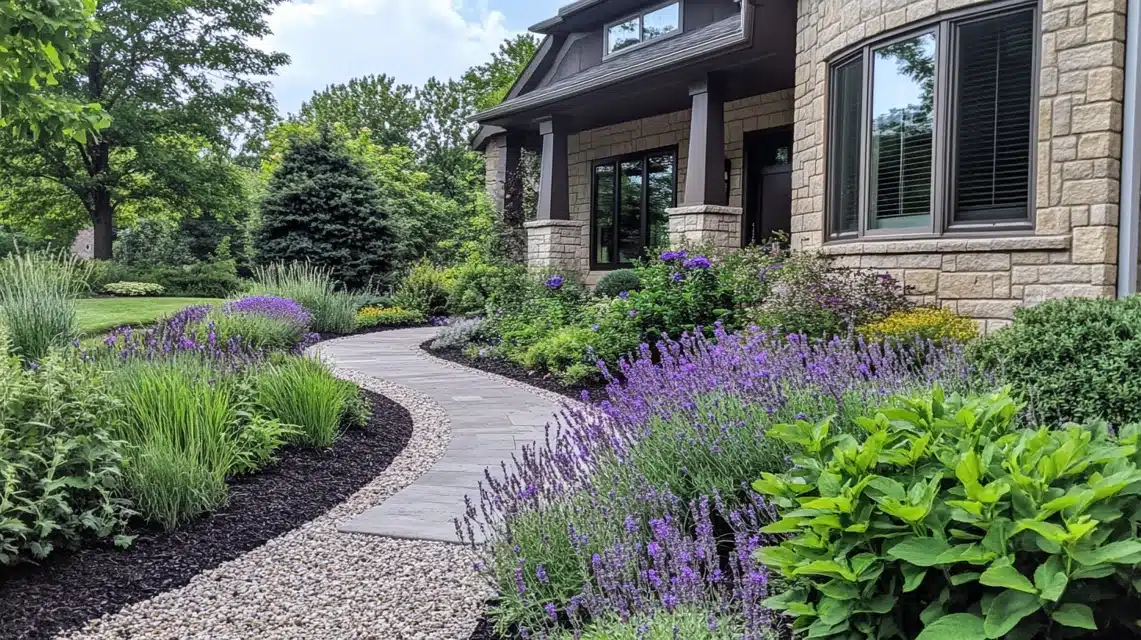
Think of your front yard as your home’s handshake with the world. How to make that first impression count:
Pathways That Welcome Create an inviting journey to your front door with curved walkways that lead visitors naturally through your landscape.
I’ve found that mixing materials like flagstone with gravel or using patterned concrete can add visual interest without breaking the bank.
One of my favorite touches is lining pathways with low-growing plants like lavender or creeping thyme, they release a lovely scent when brushed against.
Entryway Gardens That Impress Frame your entrance with symmetrical plantings that draw the eye to your front door.
Consider layering plants of different heights – perhaps boxwood shrubs as anchors, backed by ornamental grasses, and bordered with seasonal flowers.
This creates a year-round structure while allowing for pops of changing color.
Low-Maintenance Options That Last Not everyone has hours to spend gardening, and that’s okay! Try incorporating native plants that naturally thrive in your climate with minimal care.
I switched my own front yard to include drought-resistant plants like Russian sage and black-eyed susans, and they look stunning while barely needing attention.
2. Backyard Landscaping
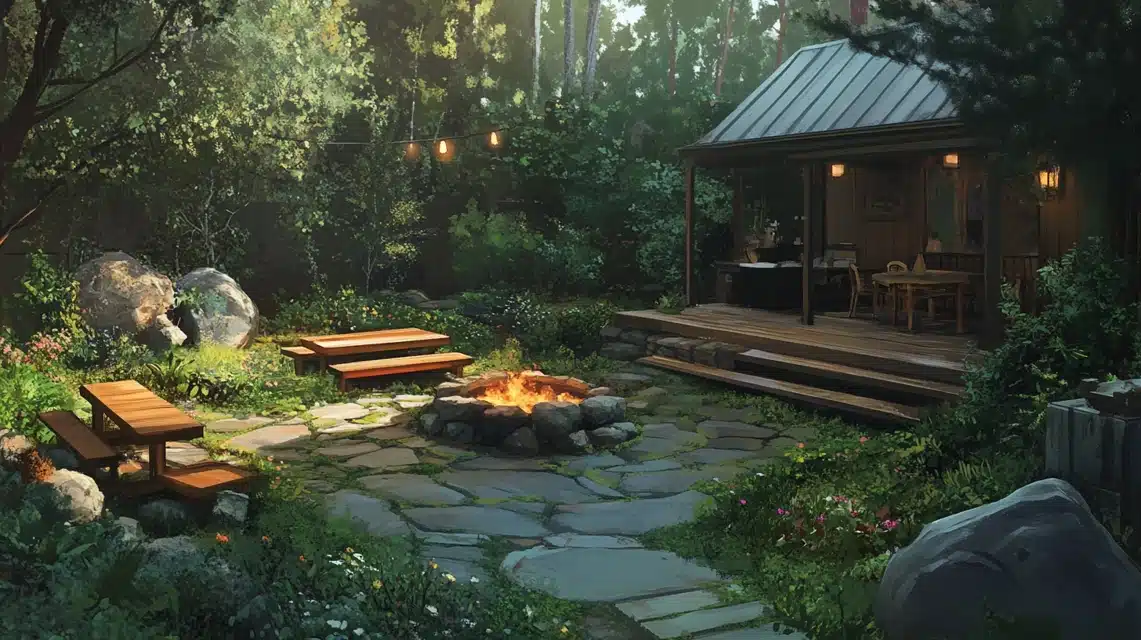
Your backyard is where you can really let your personality shine through.
Patios and Decks Create outdoor “rooms” by breaking up your space into distinct areas for different activities.
A dining zone near the house, perhaps a cozy conversation area around a fire pit, and maybe a quiet reading nook tucked into a corner.
I added built-in benches to my own deck, which doubled as storage for outdoor cushions.
Outdoor Kitchens: Even a simple setup can transform how you use your space. Start small with a quality grill and a prep surface, then add features like a mini fridge or pizza oven as budget allows.
Mine started as just a grill with a side table and evolved into a full cooking station over several years.
Play Areas Design kid-friendly spaces that still look sophisticated. Natural play elements like climbing boulders or stepping logs blend beautifully with the landscape while providing endless entertainment.
You can hide play equipment by creating strategically planted borders that offer privacy and visual interest.
3. Vertical and Small-Space Gardening

Limited space doesn’t mean limited possibilities:
Vertical Solutions Make use of vertical space with living walls, hanging gardens, or trained vines.
I’ve seen stunning gardens created on balconies using simple grid systems attached to walls. Even a small patio can become a lush oasis with the right vertical planning.
Compact Designs Use multi-functional elements to maximize space. Try built-in seating that includes hidden storage, or raised beds that double as privacy screens.
In small spaces, every element should serve at least two purposes: beauty and function.
Remember, the best landscape is one that fits your lifestyle and maintenance preferences.
Start with one area that bothers you most, and gradually work your way through your space.
The joy is in the journey as much as the destination.
Landscaping Trends to Watch
The world of landscaping is constantly evolving, and I’ve noticed some exciting shifts in how I’re approaching outdoor spaces.
Some trends that I believe are not just passing fads but meaningful improvements in how I create and maintain my landscapes.
1. Sustainable Landscaping

Sustainability isn’t just a buzzword, it’s transforming how I think about my yards. I’ve transformed my own garden to be more eco-friendly, and the results have been remarkable.
By replacing thirsty turf with drought-resistant plants like lavender, sage, and native grasses, I’ve cut my water usage by half while creating a more vibrant, low-maintenance landscape.
Rain gardens have become a particular passion of mine.
These shallow depressions filled with deep-rooted native plants capture rainwater runoff, preventing erosion and naturally filtering water before it reaches my waterways.
I positioned mine to catch roof runoff, and it’s become a stunning feature that attracts butterflies and birds while solving my drainage issues.
The materials I use matter, too. Permeable pavers allow water to seep into the ground naturally, and recycled materials like composite decking offer durability without depleting natural resources.
Even mulch choices can make a difference – I’ve switched to locally sourced wood chips, which reduce transportation emissions and support my community’s tree services.
2. Edible Landscaping

Who says vegetable gardens can’t be beautiful? I’ve discovered that mixing ornamental and edible plants creates landscapes that are both stunning and functional.
Imagine picking fresh herbs from your front yard or plucking ripe tomatoes from decorative containers on your patio!
Fruit trees can serve as elegant focal points while providing seasonal harvests. I planted dwarf apple trees along my driveway, and they create beautiful spring blooms, summer shade, and fall fruit.
Underplanted with thyme and chives, they’re productive at multiple levels.
Herb gardens deserve special mention because they’re incredibly versatile in landscaping.
I’ve used rosemary as a low hedge, created a geometric knot garden with different varieties of sage, and let creeping thyme soften the edges of my walkways.
The bonus? Fresh herbs just steps from my kitchen door.
3. Smart Landscaping
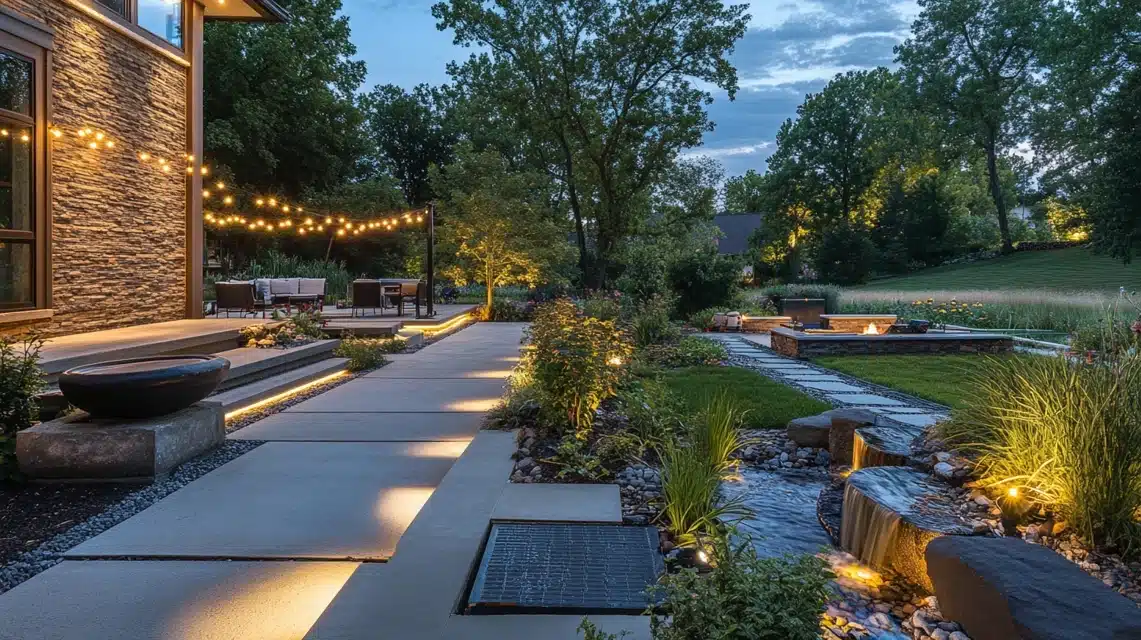
Technology is revolutionizing how I care for my outdoor spaces. Smart irrigation systems have been a game-changer in my garden.
Mine adjusts watering schedules based on weather forecasts and soil moisture levels, ensuring plants get what they need while conserving water. The system paid for itself through water savings within two years.
Solar lighting has come a long way too. Today’s options include pathway lights that automatically adjust their brightness based on surrounding light levels.
Security lights with motion sensors and even decorative string lights create a magical evening ambiance without adding to your electric bill.
Some of my favorite smart additions include:
- Weather-responsive sprinkler controls that skip watering when rain is forecast
- App-controlled LED landscape lighting that can be programmed for different occasions
- Soil sensors that send alerts to my phone when plants need water
- Solar-powered water features that create soothing sounds without running cables
The most exciting part about these trends is how they work together.
My edible garden uses smart irrigation, sustainable practices guide my plant choices, and solar lighting illuminates it all.
The result is a landscape that’s beautiful, productive, and forward-thinking.
Remember, incorporating trends doesn’t mean completely redesigning your space. Start with one element that excites you.
Maybe a small herb garden or a single, smart feature and build from there.
The goal is to create a landscape that works with nature, not against it while meeting your needs and style preferences.
Latest Eco-friendly Landscape Design Trends
1. Native Plant Communities

Creating landscapes that work in harmony with nature is not only environmentally responsible but also incredibly beautiful and low-maintenance.
I’ve transformed my own garden into a haven for local wildlife by incorporating native plants that naturally thrive in my area.
The key is to think in terms of plant communities rather than individual specimens. By grouping plants that naturally grow together, you create sustainable ecosystems that support local biodiversity while requiring minimal intervention.
2. Water Conservation Solutions
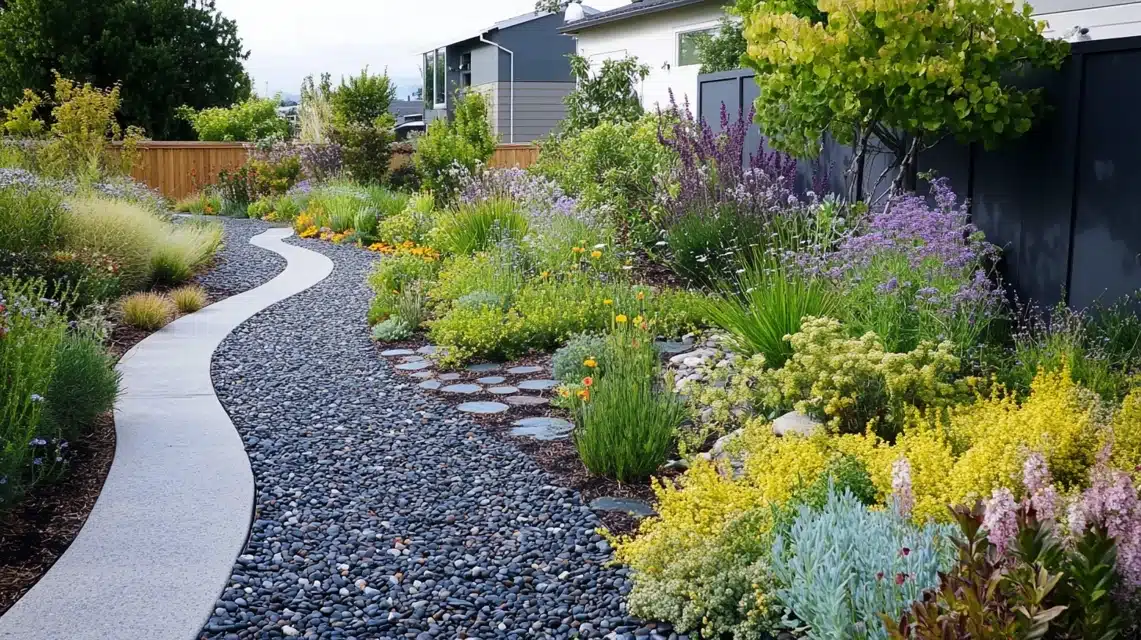
Water-wise landscaping has come a long way from simple xeriscaping. Today’s designs integrate clever solutions like rain gardens and bioswales that turn water management into attractive landscape features.
In my yard, I installed a rain garden that captures roof runoff, creating a lush oasis that needs virtually no supplemental watering.
Permeable paving materials allow water to seep naturally into the ground, reducing runoff while adding visual interest to driveways and pathways.
3. Eco-friendly Materials

The materials I choose for my landscapes have a huge environmental impact. I’ve found creative ways to incorporate recycled materials into my designs.
Old bricks become charming pathway borders, reclaimed wood transforms into raised beds, and locally sourced stone reduces transportation emissions.
Sustainable composite decking offers the look of wood without the environmental cost of harvesting trees, while chemical-free lumber alternatives provide safe options for structures near edible gardens.
4. Wildlife-Friendly Features
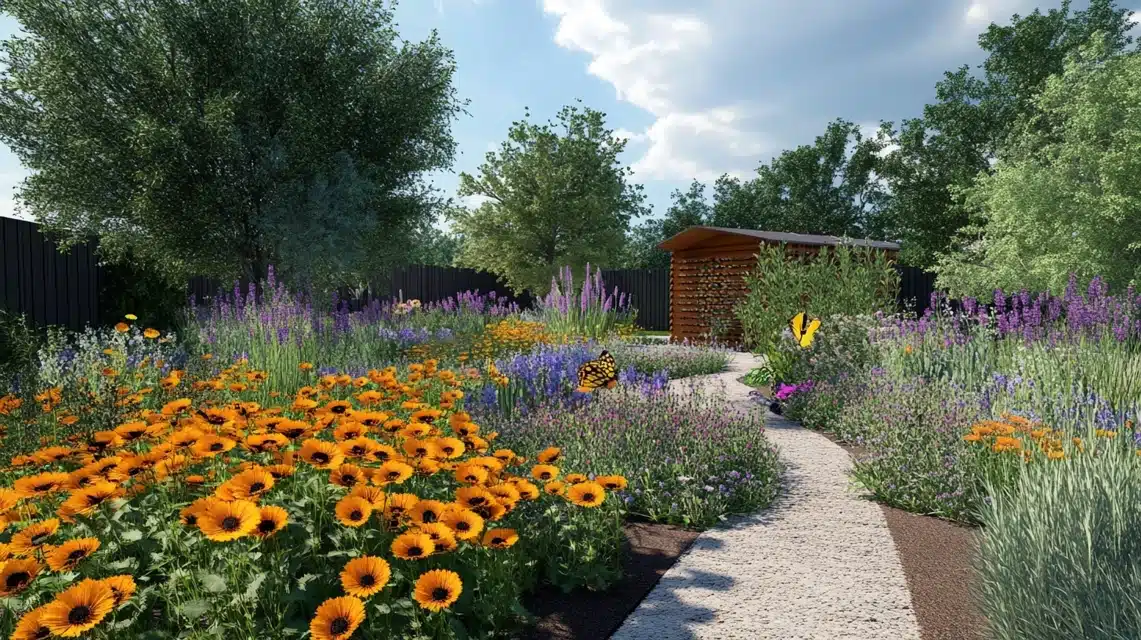
Creating a habitat for local wildlife adds both ecological value and endless entertainment to your landscape.
My pollinator garden buzzes with bees and butterflies from early spring through late fall, thanks to carefully planned succession planting.
Simple additions like insect hotels and bird baths make your garden a sanctuary for beneficial creatures.
I’ve even started leaving some seed heads standing through winter, providing natural food sources for birds.
5. Sustainable Practices
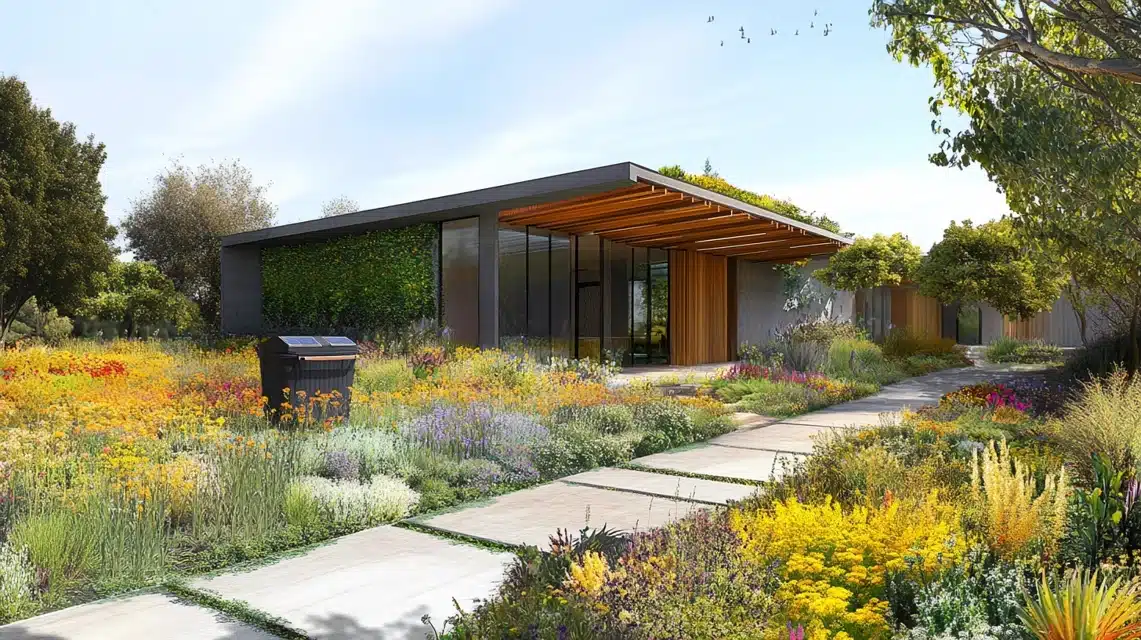
Modern eco-friendly landscaping goes beyond plant selection to embrace sustainable maintenance practices.
Composting stations can be beautifully integrated into garden designs, while solar-powered lighting reduces energy consumption.
Living walls and green roofs not only look stunning but also provide important environmental benefits like improved air quality and reduced urban heat island effect.
I’ve designated several no-mow zones in my yard, allowing natural habitats to flourish while reducing maintenance time and emissions from lawn equipment.
6. Food Production Integration

One of the most exciting trends is the creative integration of food production into ornamental landscapes.
By mixing vegetables and fruits with traditional landscaping plants, you can create beautiful, productive spaces that benefit both people and wildlife.
I’ve incorporated dwarf fruit trees as focal points, used herbs as border plants, and even created an edible hedge using blueberry bushes. The result is a landscape that’s not only sustainable but also deliciously rewarding.
Remember, transitioning to eco-friendly landscaping doesn’t have to happen all at once. Start with one area of your yard and gradually expand your sustainable practices.
The rewards, from lower maintenance costs to increased wildlife activity, make it well worth the effort.
Conclusion
Landscaping is more than just enhancing your yard, it’s about extending the warmth and personality of your home to the outdoors.
Just like a thoughtfully designed interior, a well-planned landscape creates spaces that are functional, beautiful, and uniquely yours.
Whether it’s a welcoming front yard, a relaxing backyard retreat, or a creative solution for small spaces, landscaping allows you to bring your vision to life.
At Home-Hearted Landscaping, I believe your outdoor spaces should feel as inviting and personal as your living room.
By blending thoughtful design, smart planning, and a touch of creativity, you can turn your yard into a reflection of your home’s style and heart.
Ready to start transforming your outdoor space? Whether you go DIY or work with a professional.
Remember, every step you take toward a beautiful landscape is a step toward creating a home you truly love, inside and out.
Frequently Asked Questions
What Exactly Is Eco-Friendly Landscaping?
Eco-friendly landscaping, also called sustainable landscaping, focuses on creating outdoor spaces that conserve water, support local wildlife, and minimize environmental impact.
It involves using native plants, reducing water usage, eliminating chemical pesticides, and incorporating sustainable materials and practices.
Is Eco-Friendly Landscaping More Expensive?
While initial costs might be slightly higher for some elements (like installing a smart irrigation system), eco-friendly landscapes typically cost less in the long run.
You’ll save money on water bills, reduce maintenance costs, and spend less on replacing plants since native species are adapted to local conditions.
Plus, many sustainable practices like composting and using recycled materials can actually lower your costs.
Can I Create an Eco-Friendly Landscape if I Have a Small Yard?
Absolutely! Small spaces are perfect for vertical gardens, container plantings with native species, and compact rain gardens.
Even a tiny balcony can support pollinators with the right plant choices. Focus on maximizing available space through techniques like vertical growing and multi-functional design elements.
How Do I Start Transitioning to An Eco-Friendly Landscape?
Start small and plan carefully.
- Testing your soil quality
- Identifying areas where native plants could replace existing ones
- Installing a rain barrel or creating a small rain garden
- Switching to organic maintenance practices
- Adding a few pollinator-friendly plants
Will an Eco-Friendly Landscape Attract Unwanted Wildlife?
While your garden may attract more birds, butterflies, and beneficial insects, proper design can discourage unwanted wildlife.
Strategic plant placement, appropriate fencing, and understanding local wildlife habits can help create a balance that works for your space.





